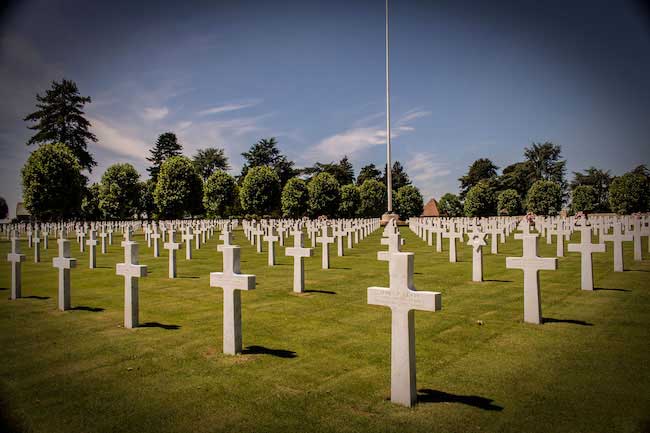French cemetery honoring Americans includes 3 from Orleans who died in WWI assault
“Overlooked Orleans” – Volume 3, Issue 36
A quiet drive through the French countryside reveals the sprawling fields of golden wheat and green stalks of corn, the wind rushing through the hedgerows, and faint sounds of cattle. The openness of the landscape is broken up by the occasional town that contains century-old homes, churches, and schools, with the irregular modern buildings that house every amenity needed for the local community.
After passing eastward through the small village of Bony, one is greeted by an immense marble structure that displays the French phrase “Morts pour la patrie,” or “To those who died for their country.”
The Somme American Cemetery, situated on 14.3 acres of rolling countryside in the Picardie region, is the final resting place for over 1,800 men who died during the assault on the Hindenburg Line on September 29, 1918. The cemetery was peaceful while a small crew of caretakers meticulously aerated the grass amidst the rows of marble crosses. Despite the significance of the battle during which these men were killed, the last visitors to the cemetery came in April of 2017 when I visited in early July.
A beautiful marble chapel looms over the cemetery, the massive marble altar inside contains the inscription “Thou o Lord has granted them eternal rest.” The four sections of grave plots are surrounded by flowering plants and trees, while most notable are the beds of polyanthus roses that adorn the area near the flagpole at the center of the cemetery.
On this hallowed ground rests 138 unidentified soldiers, whose graves are marked by stones reading “Here rests in honored glory an American soldier known but to God.” Not secluded in their own area, these brave souls rest among their fellow soldiers who rest in graves marked by Latin Crosses and Stars of David.
Among the graves are all familiar names, such as PFC Albert Beary, who left his young wife a widow after their marriage took place less than one year earlier. In an adjoining section rests Pvt. Jesse Brooks, whose life was cut short after volunteering for a reconnaissance mission near St. Quentin on October 14, 1918.
Yet far away from his fellow soldiers from Orleans County lies the body of Cpl. James P. Clark who courageously led his men after all other officers were either killed or wounded. Nearly twenty minutes after assuming command of his unit, he was gunned down by machine gun fire. The courage and tenacity exhibited by Clark on September 29, 1918 earned him the Distinguished Service Cross, prominently noted upon his marble cross.
This beautiful burial ground stands upon the same ground that these men sacrificed their lives upon. Overlooking the small village of Bony, it serves as a reminder that some men never reached their final objective. This sacred ground is overpowered by other monuments such as the massive Thiepval Memorial to the Missing of the Somme, a memorial that stands like a fortress in the French countryside, calling to memory the names of over 72,000 British and South African men who died in 1915 and 1918. Yet its quaint beauty is to be appreciated, a true representation of honor to our fallen soldiers who sacrificed so much nearly 100 years ago.







































































